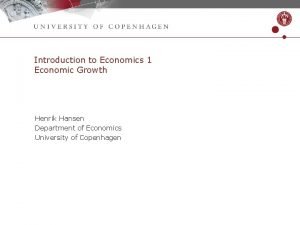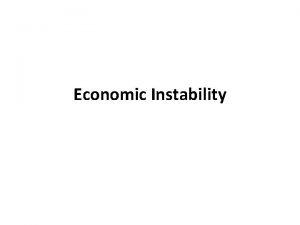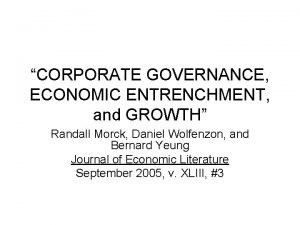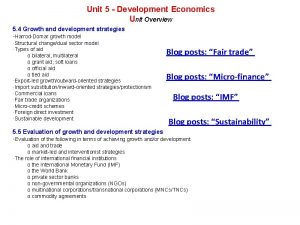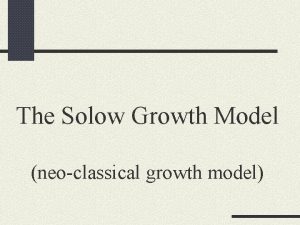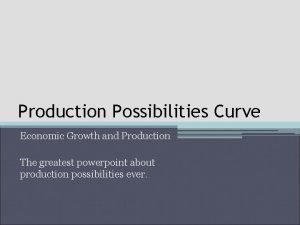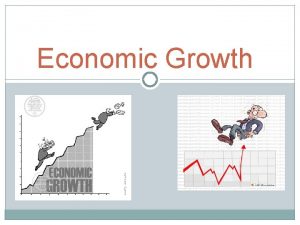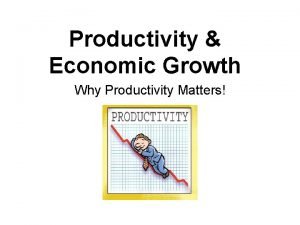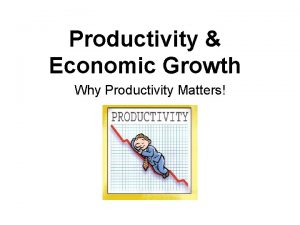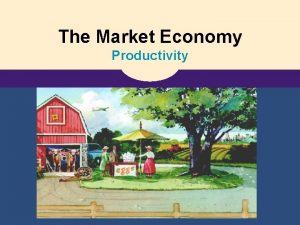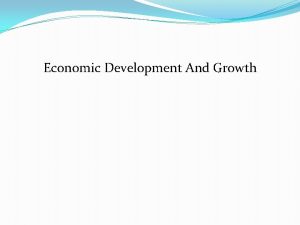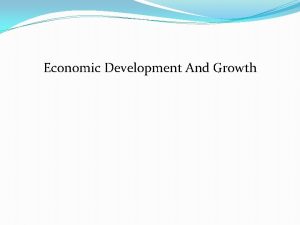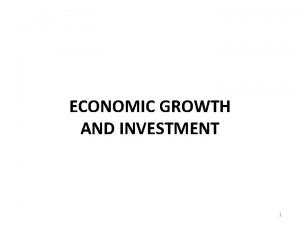PRODUCTIVITY AND ECONOMIC GROWTH THE ROLE OF THE



















- Slides: 19

PRODUCTIVITY AND ECONOMIC GROWTH. THE ROLE OF THE LABOR MARKET August 29, 2008 Magyar Nemzeti Bank and Ministry of Finance A New Regional Geography of Europe? The Labour Market Impact of the EU enlargements Floro Ernesto Caroleo University of Naples Parthenope and IZA Bonn Francesco Pastore Seconda Università di Napoli and IZA Bonn Email: fpastore@unina. it

Outline n Previous surveys and aims of the paper n The Labour Market Impact of Structural Change n Factors of persistent structural change n The Impact of labour and capital mobility n Human Capital as a Factor of Regional Convergence n National and EU Regional Policy

Previous surveys n Boeri (2000): role of labour supply q n Bornhost and Commander (2006): q n Evidence on 6 CEE countries confirming the role of low labour market flexibility Ferragina and Pastore (2006): q n Low labour turnover and rigid labour market institutions Within the OST literature, high local unemployment is due to high labour turnover and industrial restructuring Huber (2007): role of trade and FDI q Integration caused regional divergence and labour flexibility, though higher than the EU, was insufficient to compensate

Motivation n The emphasis of traditional models on factor mobility is under challenge: q q n n Labour market flexibility has increased But capital and labour mobility seem to cause divergence, not convergence Is Eastern Europe becoming a new Mezzogiorno? The hypothesis of similar endowment and technology across regions does not hold Regional unemployment is now a market and a state failure Need for new explanations and policy

Aims of this survey n Focus on the role and determinants of structural change n Emphasize the spatially asymmetric nature of structural change: q q q n Human capital endowment Economies of scale Trade and FDI flows Differences and similarities between old and new member states

The labour market impact of structural change: The Optimal Speed of Transition literature

Optimistic and non optimistic view n Optimistic view: q With structural change coming to an end unemployment should be fully absorbed q The process should be relatively fast n Pessimistic view: q Structural change finds always new sources q Shocks are asymmetric across regions and sectors q Unemployment becomes easily persistent due to labour market rigidities

Regional unemployment and structural change: A graphical representation based on the OST models

Two hypotheses about regional unemployment n n Hypothesis H 1 regional unemployment depends on: q q n Increase labour market flexibility Educational policy ALMP Hypothesis H 0 Regional unemployment depends on: q low outflows in high unemployment regions Stagnant unemployment pools Policy implications: q n Persistently different degrees of labour turnover Long-term unemployment is a consequence, not a cause of regional unemployment Policy implications: q q Transition should be gradual in HURs Increase the life expectancy of private businesses in HURs

Testing H 1: Industrial restructuring, labour turnover and local unemployment IR → LT → RU Empirical problem: finding an exogenous measure of industrial restructuring

A note on the Krugman hypothesis The Krugman’ hypothesis on USA vs EU: n q q n n Does it apply at a regional level? An alternative hypothesis based on H 1/H 0? q q n At a country level, higher flexibility means lower unemployment; Unemployment is a consequence of low labour market flexibility hindering job creation Where labour turnover is constant across regions, initial asymmetric shocks cannot be absorbed in high unemployment regions because of low labour flexibility Where high unemployment is coupled with high labour turnover, unemployment depends on persistent industrial restructuring Two types of regional unemployment 1. 2. Due to low job creation Due to high and persistent structural change

Causes of persistent structural change Structural change is a constant across countries and n over time: q In CEECs, it is due to economic transition and now EU integration q In the EU-15, it is due to globalisation, tertiarisation and technical change q Other factors causing high labour turnover: n n n Low competitiveness and dependence on developed regions Low local attractiveness of FDI Low human capital Low social capital High degree of criminality Rent-seeking of state funds

Regional job and worker turnover: the evidence In favour of H 0: n Boeri (2000) in several transition countries Boeri and Scarpetta (1996) in several transition countries World Bank (2001) Rutkowski (2003) in Poland q q In favour of H 1: n Lehmann and Walsh (1999) suggest that where human capital is fungible, restructuring is high Newell and Pastore (2006) in Poland Contini and Trivellato (2006) in the Italian Mezzogiorno q q q Differences are due to: n Different experiences across countries Different data used: q q n n Job flows versus worker flows Monthly and quarterly versus annual flows

Is migration increasing or reducing regional unemployment? n In traditional models, regional unemployment is an inverse function of the degree of factor mobility n In NEG and other Non-neoclassical models migration reinforces regional unemployment disparities n Evidence: q Internal migration flows are low in the EU 25 because of: n n q q High housing costs; Insufficient wage differentials But the wage curve is similar in EU countries, with few exceptions (Italy) Migration contributes to the concentration of high skill workers in urban areas

Human capital as a factor of regional divergence n Human capital is higher in low unemployment regions. Explanations: q q n Private returns are higher because of different composition of local labour demand Complementarity with high-tech industries causes human capital concentration and economies to scale Empirical evidence: q q Moretti finds evidence of social returns to education in the USA Juraida fails to find such effects in the Czech Republic

The effect of trade and FDI on regional labour markets n n NEG suggests trade and capital flows tend to reinforce, not weaken regional unemployment differences The evidence confirms this: q q High degree of polarisation of FDI in core regions Economies to scale prevail on decreasing returns to capital

National and EU regional policy n n n Maastricht and competition policy impose strong constraints to national policy The EU regional policy has proven to be ineffective (with few exceptions: Marche and Ireland): Boldrin and Canova Debate is on the intermediate objectives of the EU regional policy q q Redistribution of income Infrastructures Human capital, R&D etc. Labour mobility and so on

Concluding remarks n n Remarkable similarities between old and new member states Persistent structural change is the cause of regional unemployment The recent literature challenges the traditional view that regional unemployment is a consequence of slow adjustment process, Other factors to consider: q q q Low competitiveness Low attractiveness to FDI Low human and social capital endowment

Benefit systems and their interaction with ALMP n n n Common to the debate in the EU 27 is the fear that passive policy causes further regional unemployment divergence Need stressed to move towards pro-active schemes Convergence in expenditure on passive income support and pro-active schemes
 Conclusion of growth and development
Conclusion of growth and development Economic growth vs economic development
Economic growth vs economic development Define growth analysis
Define growth analysis Pith
Pith Primary growth and secondary growth in plants
Primary growth and secondary growth in plants Chapter 35 plant structure growth and development
Chapter 35 plant structure growth and development Ssema
Ssema Economic growth and development
Economic growth and development Economics chapter 13 vocabulary
Economics chapter 13 vocabulary Corporate governance and economic growth
Corporate governance and economic growth What is web role and worker role in azure
What is web role and worker role in azure Carothers equation
Carothers equation Geometric growth vs exponential growth
Geometric growth vs exponential growth Neoclassical growth theory vs. endogenous growth theory
Neoclassical growth theory vs. endogenous growth theory Organic vs inorganic growth
Organic vs inorganic growth Application of harrod-domar model in developing countries
Application of harrod-domar model in developing countries Aggregate production function
Aggregate production function Ppc curve economic growth
Ppc curve economic growth Long run economic growth
Long run economic growth Long run economic growth
Long run economic growth







